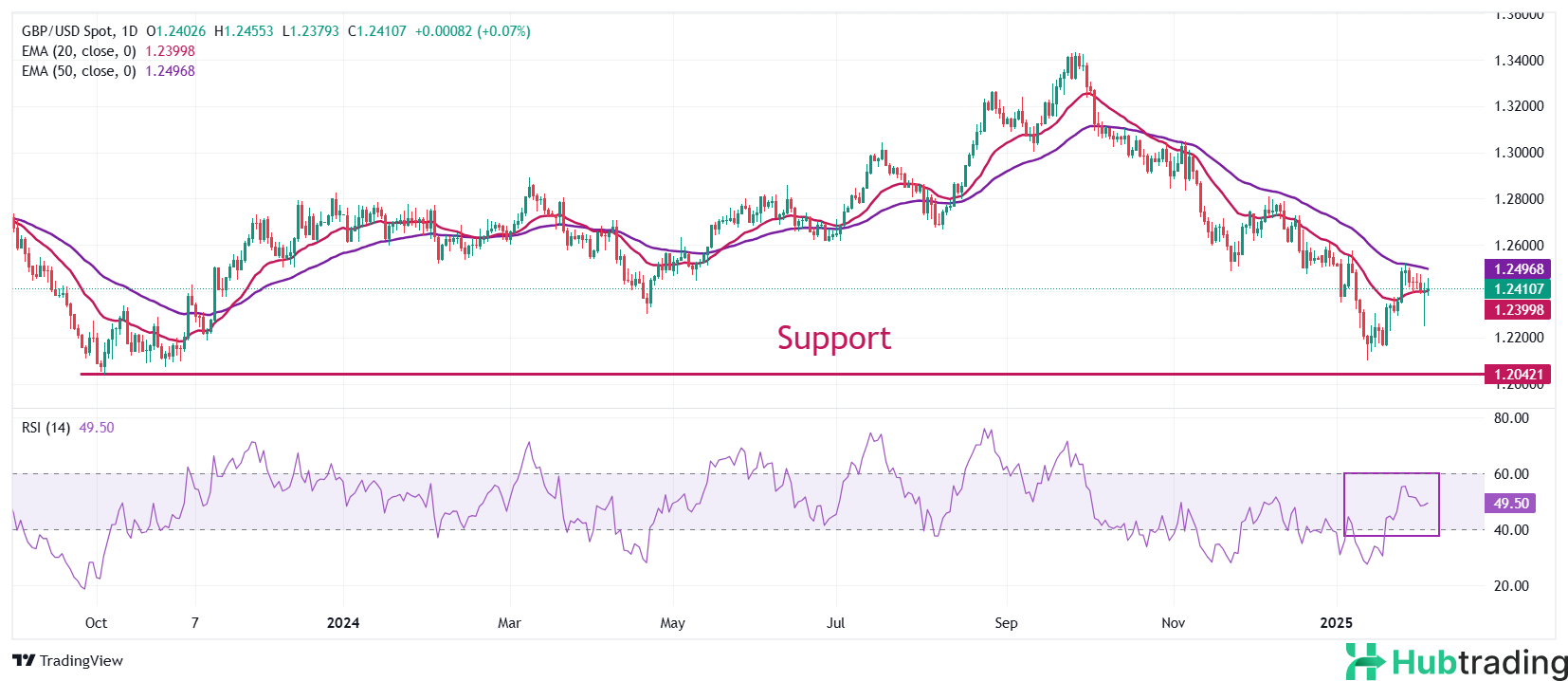- The Pound Sterling has climbed above 1.2400 against the US Dollar amid concerns that the US-China trade war could intensify.
- In response to US President Trump's tariffs, China has imposed additional levies on various US imports.
- This week, investors will closely watch the Bank of England's policy decision alongside the US Nonfarm Payrolls data.
The Pound Sterling (GBP) underperforms its major peers - aside from safe-haven assets - on Tuesday as investors await the Bank of England's (BoE) monetary policy decision scheduled for Thursday. Money market expectations indicate that traders have priced in an 81 basis point interest rate cut for this year, implying that more than three 25 basis point cuts could be implemented by December, with the first anticipated this week to lower borrowing rates to 4.50%.
Meanwhile, yields on 30-year UK gilts have dropped to around 5.04%, their lowest level in nearly two weeks. This decline reflects optimism that US President Trump may avoid launching a severe trade conflict with Britain. Over the weekend, Trump hinted at uncertainty regarding the imposition of tariffs on the UK, suggesting instead that a deal could be reached, especially since Prime Minister Keir Starmer has been "very nice."
Previously, UK gilt yields experienced a strong rally from November 29 to January 13 as investors grew increasingly concerned about the economic outlook amid fears of potential US tariff hikes.
Daily Digest Market Movers: Pound Sterling Recovers Against USD as Trump Pauses Tariffs on North American Partners
- The Pound Sterling rebounds from an intraday low of 1.2380 against the US Dollar during Tuesday's European session, although it remains about 0.2% lower at approximately 1.2430. This recovery comes as the US Dollar struggles to maintain strength following President Donald Trump's decision to suspend 25% tariffs on Canada and Mexico for 30 days.
- According to Reuters, President Trump agreed to the 30-day pause in exchange for concessions on border and crime enforcement from the two neighboring countries. This announcement triggered a sharp decline in the US Dollar, with the US Dollar Index (DXY) - which tracks the Greenback against six major currencies - trading cautiously near 108.50.
- The delay in tariff orders on North American partners has provided significant relief for risk-sensitive assets globally. However, Trump's commitment to imposing a 10% tariff on China, with threats to escalate further, continues to weigh on investor sentiment. In retaliation, China has imposed tariffs on US imports, including a 15% levy on coal and liquefied natural gas (LNG) and a 10% duty on crude oil, farm equipment, and certain autos, as reported by Reuters.
- Looking ahead, the next key event for the US Dollar will be the release of the January US Nonfarm Payrolls (NFP) data on Friday. This employment report is expected to heavily influence market expectations regarding the duration of the Federal Reserve's current wait-and-see approach to interest rates. Fed Chair Jerome Powell recently noted that only "real progress in inflation or at least some weakness in the labor market" would prompt a change in the monetary policy stance.
- Additionally, investors will monitor Tuesday's release of the December JOLTS Job Openings data at 15:00 GMT. Economists predict that job openings will be around 8 million, slightly down from nearly 8.10 million in November.
Technical Analysis: Pound Sterling Seeks Stability Above 1.2400

The Pound Sterling is striving to establish a solid base above 1.2400 on Tuesday, with the GBP/USD pair trading above its 20-day Exponential Moving Average (EMA) at that level. However, the near-term outlook remains mixed as the 50-day EMA, around 1.2500, continues to present resistance for bullish sentiment.
The 14-day Relative Strength Index (RSI) is hovering within the neutral 40.00 - 60.00 range, indicating a period of consolidation. On the downside, key support is expected at the January 13 low of 1.2100 and the October 2023 low of 1.2050, while the December 30 high of 1.2607 is poised to act as a significant resistance level.





